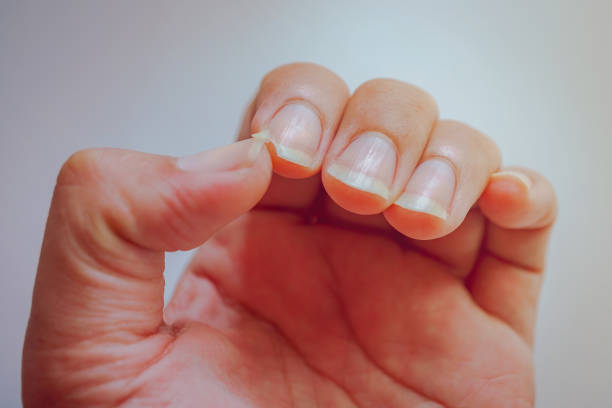
Every day, hands are exposed to harmful substances and toxins. This split skin can allow bacteria to enter the body and cause a rough or untidy cuticle, which could lead to various diseases. This skin area must be treated with equal importance. Contrary to popular belief, the cuticle does not surround the nails. The cuticle, a thin layer of almost transparent skin, protects newly painted nails from infection. The “Eponychium,” the area around our nails, is susceptible to dryness, itching, flakiness, or illness.
What causes the skin to peel around your nails?
According to Dr. Mittal, there are several causes.
1. Environmental factors: The environment significantly impacts the health and appearance of our skin. The skin around your nails can peel due to dry weather, cold temperatures, and winters. Outside forces significantly impact the general health and smoothness of our skin. The skin around your nails can peel due to dry weather, cold temperatures, and winters.
2. If you bite your nail, it could damage your cuticles, nails, or skin. These damaged cuticles can lead to an infection. This is one of many causes of skin peeling in anxious children and adults.
3. Peeling nails can also be caused by a lack of nutrients, such as vitamins or calcium. Lack of nutrients can cause the skin to become dry, flaky, and peel. Pellagra is a condition characterized by diarrhea, dementia, and dry skin. A lack of vitamin B-3 or niacin causes it.
4. Salons may sometimese be unaware of how to care for your skin. Since the skin on your hands and feet is softer, it can be damaged by rough handling when getting nail extensions or having a pedicure or manicure. Some experts, especially those specializing in the nail extension procedure, can remove any cracking or dryness of the nail film. Like your skin, your nails can be infected by bacteria and viruses.
5. Skin disorders or infections: Eczema and psoriasis are two conditions that can cause the skin around your cuticle to peel. Chronic infections such as bacterial or fungus infections (caused by dampness) can cause the skin to peel around the cuticle. It is best to consult a skin specialist if you cannot cure this condition yourself.
6. Constant or excessive handwashing: Washing your hands constantly with soap can damage the lipid layer on your skin. This allows the soap to irritate your skin and cause it to peel.
7. Items that contain harsh chemicals can cause skin to peel around the fingers. Professionals, homemakers, and others are among those who experience rough skin around their fingertips.
How to treat cuticles that are damaged and the skin around them
Dr. Mittal offers simple solutions to damaged cuticles, skin peeling, and cracked nails.
- Washing your hands with hot water can cause skin dehydration. Those with sensitive skin should avoid this.
- Rub your hands with some aloe sap. Rub ghee onto your hands before cooking if you cook more often than usual. This will protect them from any harm caused by cutting acidic foods such as tomatoes, onions, and potatoes. You can use olive, almond, coconut, or even almond oil.
- Rub malai onto your hands while reading a book or watching a movie for 10 minutes. Then, wash your skin with warm water. Milk cream is an excellent hydrator and regenerator of skin.
- To prevent pores from opening, moisturize your palms three times a day. After wetting your hands, wear socks to get the best results. Try it for one hour if you cannot do it the whole night. This will increase absorption. If your palms sweat, avoid doing this, as it can aggravate the condition.
- Fruits are great for your skin. Be cautious when consuming foods rich in iron, biotin, and vitamin B12.
- As much as you can, keep your hands off your lips.
- Keep your hands warm to prevent the cold from taking hold.
- Avoid nail polish removers containing highly abrasive acetone. Your eponychium may become dry as a result. However, it could also suffer long-term damage. Search for cleaners containing healthy oils.
- It would help if you took good care of the skin and cuticles.





